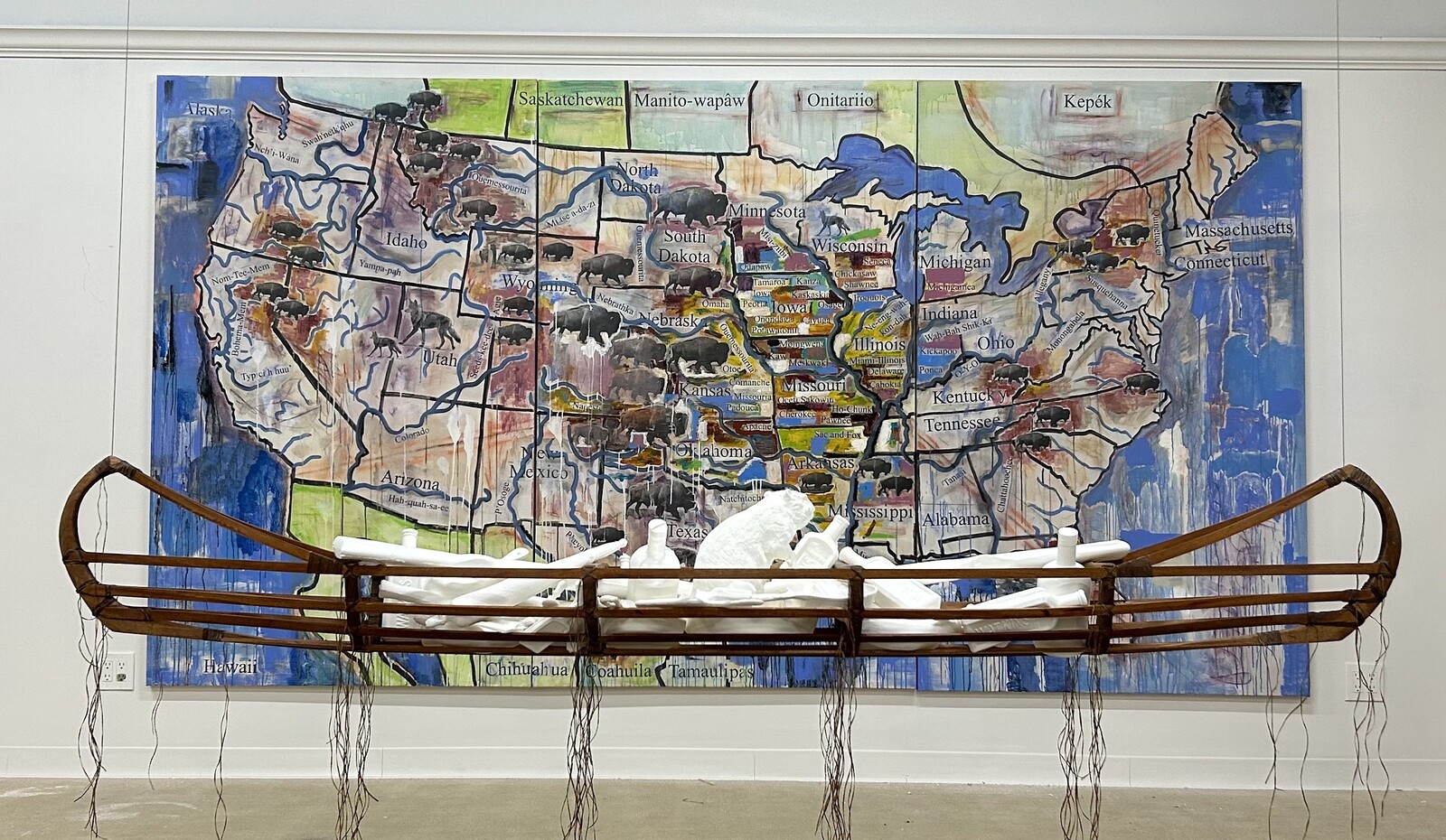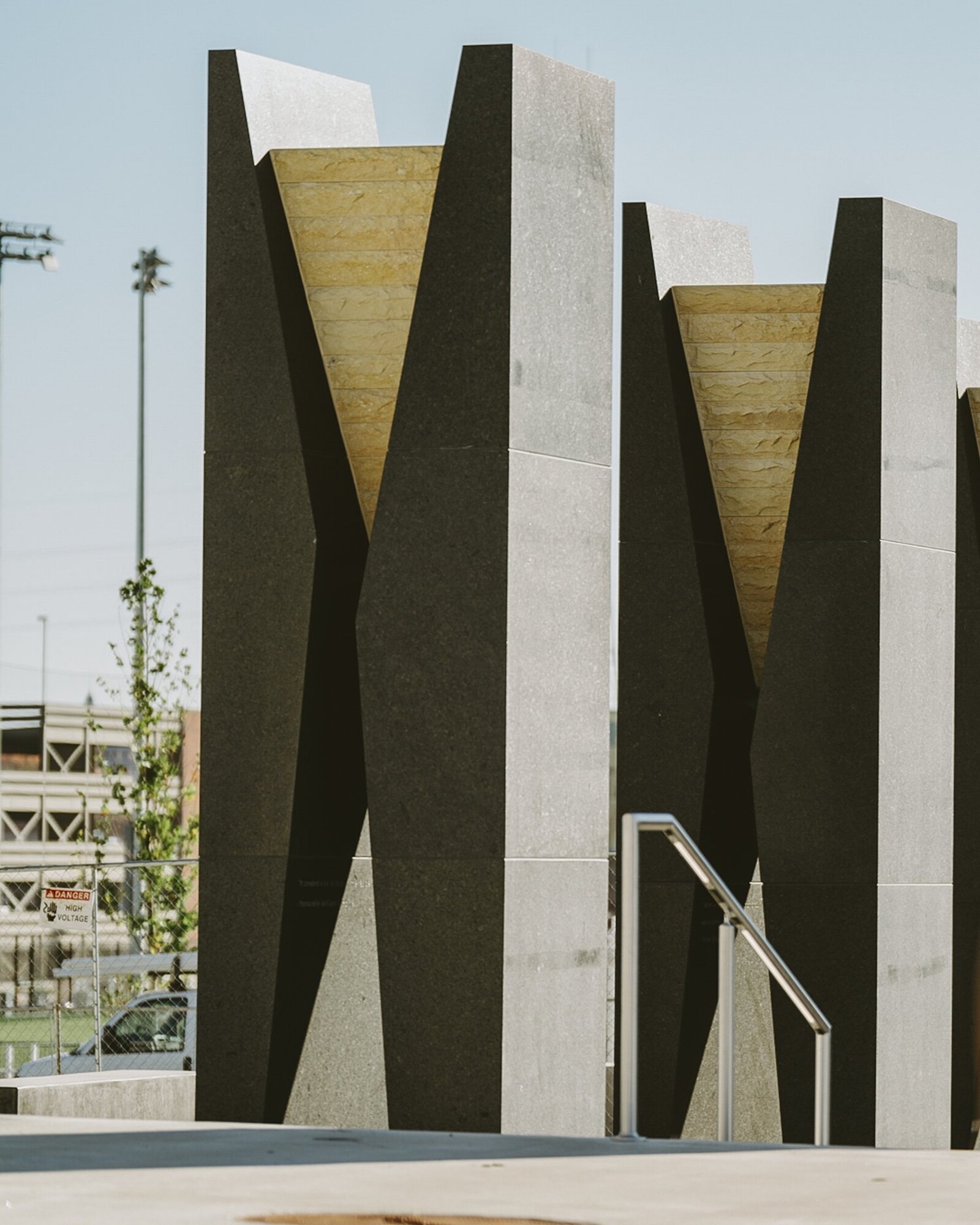April 15–July 15, 2023
What is a public? According to the literary critic Michael Warner, it is a relation between strangers bound together by law, belief, or shared experience. But as he also points out, the public is a dominant community that excludes subaltern groups who must form “counterpublics” to create alternative forms of community and discourse to survive the onslaught of structural oppression that the public produces. This notion inspired the St. Louis–based triennial Counterpublic, founded in 2019. Its second iteration features thirty commissioned artworks spread throughout the city. Artistic director James McAnally, along with a curatorial ensemble that included Allison Glenn, Risa Puleo, Diya Vij, and the “public secret society” New Red Order, chose artworks in relation to a city that has faced both Indigenous displacement and racial violence, from the 1857 Dred Scott case to the 2014 murder of Michael Brown by Ferguson police. The resulting exhibition successfully calls attention to the ways in which these and other complex histories are embedded within the city’s urban fabric.
Counterpublic 2023 feels like a combination of Documenta 15, centered on community and collaboration, and Prospect, a triennial that focuses on the social and political dimensions of New Orleans. Its deep connection to St. Louis begins with a set of works at Sugarloaf Mound, believed to have been built for burials or rituals by native communities predating European and African arrival, as far back as 1000 BCE. Like many others in the US, this site is caught between a river, a railway, and a highway—lines of transportation that trace the cycles of urban spatial violence in the name of progress.
Anna Tsouhlarakis’s billboard The Native Guide Project: STL (all works 2023) overlooks this mound, which is now owned by members of the Osage Nation. It reads: “WHEN YOU LISTEN THE LAND SPEAKS.” On the other side, a billboard by New Red Order, Give it Back: Stage Theory, reads: “Got Land? Give it back!” The phrase was echoed in their related video (which shares the same title) shown at the St. Louis Art Museum, built after burial mounds were razed to make way for the Louisiana Purchase Expedition, or St. Louis World Fair. Held in 1904, this event included a human zoo in which living Indigenous people were displayed, a dehumanizing spectacle staged in the name of science. A nearby field is home to WayBack by Anita and Nokosee Fields: forty wooden platforms that replicate those used by the Osage Nation for naming ceremonies or weddings.
In Diné-American composer Raven Chacon’s public sound work Music for 13 Paths, thirteen performers, each with metal chimes tuned to thirteen pitch intervals between the traditionally twelve-note western octave, set off from different points in the city with members of the public in tow, until their paths gathered at Benton Park. The park abuts Arsenal Street, named after a US munitions site during the nineteenth-century wars of removal: a reminder that St. Louis was the central platform for US settler colonialism and westward expansion. This is the reason why Saarinen’s gateway arch was built in 1965. Chacon’s sound sculpture, by contrast, is an anti-monumental intervention—which is why it succeeds.
The north-south corridor of Jefferson avenue traverses historical borders of segregation. REGULAR DEGULAR, a video work by the choreographer Will Rawls, follows dancer Heather Himes Beal as she walks along this path, stopping at Johnnie Brock’s Dungeon, a kitschy costume store; McDonald’s, where a spontaneous dance party erupts; the Barr branch of the St. Louis Public Library; and a church, where she boxes a demon. The sites depicted in the film are also exhibition venues, in which visitors experience the video in fragments, coaxing us to follow a similar Situationist dérive. Artist Steffani Jemison often centers her practice on dance or music. Sky Is the Only Roof, a sound piece experienced on a Ferris wheel, gives a view of Mill Creek Valley. One of the largest African American communities in the twentieth century, known as the birthplace of ragtime but displaced as a result of an urban renewal project. Made in collaboration with the senior local performers Jackie and Papa Wright, this abstract soundscape is lyrical and haunting.
That community engagement is central to this project was evident during David Adjaye’s appearance at the Griot Museum on the opening weekend. Along with the Vashon Museum, another venue down the street, the Griot is an archive of local Black life created by a set of families, whose collection of photographs, documents, and objects documents the lives of doctors, entrepreneurs, politicians, and civil rights leaders. The Ghanaian-British architect’s Asaase III, when eventually completed, will consist of six curved walls made of locally sourced rammed earth in a lot adjacent to the museum. One of the historical extraction economies tied to the history of the city is red brick. During his appearance, Adjaye said of the piece-in-progress (his first permanent public artwork) that while soil is thought of as historical, it is also futuristic because it absorbs carbon dioxide and microbes as it hardens, cleaning the air in the process. If Sugarloaf Mound represents a deep history, Adjaye suggests that his sculpture points to an opposite temporality. The work remains incomplete, so it’s yet to be seen whether its lofty conceptual goals will translate into reality. Yet it was powerful to witness this event among a community as they collectively hoped for a better future.
Damon Davis’s Pillars of the Valley is a large abstract stone sculpture and monument to the displaced people of Mill Creek Valley. Torkwase Dyson created Bird and Lava (Scott Joplin), a black wooden pavilion that features a sound piece that also pays homage to ragtime. The Obadike work, SlowDrag, was a procession by a set of local car clubs down a St. Louis Place neighborhood playing a series of hip hop remixes of the blues standard “Black Angel Blues.” These artists represented a range of approaches on the spectrum of permanence vs impermanence in their address to communities. Permanence is useful when it builds sustainable infrastructure or gives visibility to historically disenfranchised groups, but it can also root structural inequity. Ephemeral projects counteract the latter tendency by allowing counterpublics to gain power.
Dyson’s pavilion and Mendi + Keith Obadike’s performance were just minutes away from the site of Pruitt-Igoe, a segregated housing project built in the 1950s. Its demolition two decades later became a symbol of the failures of modernist urban renewal projects and for many years the rubble that remained echoed the ruins of industrial buildings from the city’s economic heyday. This site is emblematic of the forces behind historian Walter Johnson, in 2020, declaring St. Louis “the broken heart of America.” It’s a warning against placing too much faith in permanence, showing us that concrete, brick, and stone can return to the earth, just as we do.
Contrastingly, another Counterpublic artist, Juan William Chávez, has been creating a bee sanctuary at Pruitt-Igoe for a decade, not only imagining but creating a vital post-collapse ecology. As the present contends with history, Counterpublic 2023 manages a rare balancing act. At once incredibly sensitive to its local topography and linked to national and global patterns, this is a show in which mounds of modernist rubble, Indigenous burial grounds, and beehives rhyme towards a potential future.





